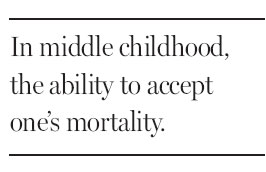Past cute age, brain grows up
Updated: 2012-01-08 07:59
By Natalie Angier(The New York Times)
|
|||||||

Said to begin around 5 or 6 and to end when the teenage years commence, middle childhood certainly lacks the irresistible cuteness of babydom and the secondary sexual turbulence of pubescence.
Yet as new findings make clear, middle childhood is a time of great cognitive creativity and ambition, when the brain has pretty much reached its adult size and can focus on forging, organizing, amplifying and annotating the tens of billions of synaptic connections that allow brain cells and brain domains to communicate.
Middle childhood is when the parts of the brain most closely associated with being human finally develop: our ability to control our impulses, to reason, to focus, to plan for the future.
Subsidizing the deft frenzy of brain maturation is a distinctive endocrinological event called adrenarche, when the adrenal glands begin pumping out powerful hormones known to affect the brain, most notably the androgen dihydroepiandrosterone, or DHEA. Researchers see adrenarche as a signature feature of middle childhood every bit as important as puberty.
Adrenal hormones are potent antioxidants and neuroprotectants, said Benjamin Campbell, an anthropologist at the University of Wisconsin in Milwaukee, and may well be critical to keeping neurons youthfully spry.
Evidence also suggests that the hormones divert glucose in the brain to foster the maturation of the insula and anterior cingulate cortex, regions vital to interpreting social and emotional cues.
Young children may know something about death, but only in middle childhood is the brain capable of practicing "terror management" and of accepting one's inevitable mortality.
Researchers studying the fossil record suggest that a prolonged middle childhood is a fairly recent development. Others have analyzed attitudes toward middle childhood historically and cross culturally. The researchers have found that virtually every group examined recognizes middle childhood as a developmental watershed, when children emerge from dependency and start taking their place in the wider world.
Much of the new work on middle childhood was described recently in the journal Human Nature.
During middle childhood, adult teeth start growing in, allowing children to diversify their diet. The growth of the skeleton, by contrast, slows. "Adulthood is defined by being skeletally as well as sexually mature," said Jennifer Thompson of the University of Nevada, Las Vegas. "A girl may have her first period at 11 or 12, but her pelvis doesn't finish growing until about the age of 18."

The 18-year time frame of human juvenility far exceeds that seen in any other great ape, Dr. Thompson said. Chimpanzees, for example, are fully formed by age 12. With her colleague Andrew J. Nelson of the University of Western Ontario, Dr. Thompson analyzed fossil specimens from early hominids, and concluded that their growth pattern was more like that of a chimpanzee.
Life for Neanderthals was nasty and short, Dr. Thompson said, and Neanderthal children had to get big fast. Our extreme form of dilated childhood didn't appear until the advent of modern Homo sapiens roughly 150,000 years ago, she said, when adults began living long enough to ease pressure on the young to breed.
"It's consistent across societies," said Dr. Campbell.
Parental expectations rise accordingly. "Kids can do something now," said Dr. Campbell. "They have economic value."
Karen Kramer and Russell Greaves of Harvard University compared the average number of hours that girls in 16 different traditional cultures devoted each day to "subsistence" tasks apart from child care. Girls of the Ariaal pastoralists in northern Kenya worked the hardest, putting in 9.6 hours daily. Agriculturalist girls in Nepal worked 7.5 hours a day.
Then there are the foragers. With the Pume, a group in Venezuela, preadolescent girls forage less than an hour a day, significantly less than their brothers. "Pume girls spend their time socializing," Dr. Kramer said.
But most cultures mark the beginning of middle childhood with some new responsibility, like growing gardens or preparing family meals.
In middle childhood, the brain is at its peak for learning, organized enough to attempt mastery yet still fluid and elastic. Children practice their fine motor skills.
"This is the period when kids move out of the family context and into the neighborhood context," Dr. Campbell said.
The all-important theory of mind arises: the awareness that other people have plans and desires. Children become obsessed with social groups, and divide along gender lines. They have an avid appetite for learning social rules, and are keenly attuned to questions of fairness and justice.
In middle childhood, the brain is open for suggestions.
The New York Times
(China Daily 01/08/2012 page11)